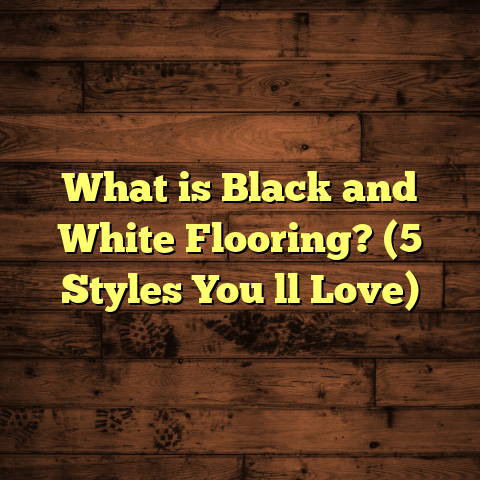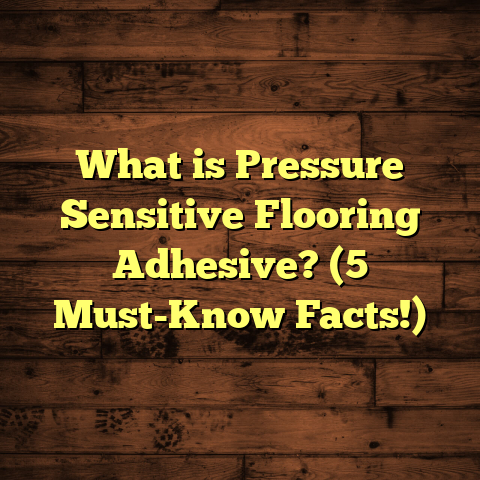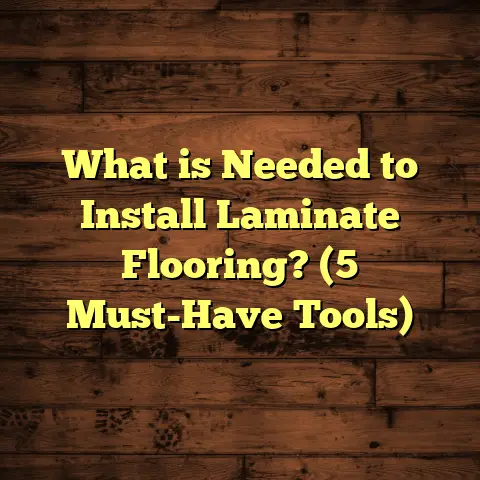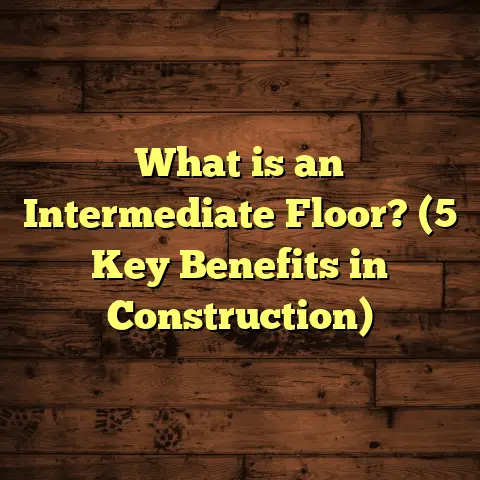What is Vallaria Engineered Hardwood Flooring? (5 Key Benefits)
I recently had a client who was renovating a century-old home in the Midwest. They wanted to keep the classic charm but needed floors that could handle daily wear from a busy family with kids and dogs. They were worried about the common issues with traditional hardwood floors—warping, cracking, and costly maintenance. That’s when I introduced them to Vallaria Engineered Hardwood Flooring. I could tell they were curious but skeptical at first. After all, they’d always thought solid hardwood was the only “real” option. After the project wrapped up, they were thrilled—not just with how beautiful the floors looked but how easy they were to live with. That experience planted a seed for me: many homeowners might be missing out on what Vallaria offers.
What is Vallaria Engineered Hardwood Flooring?
Let’s start at the beginning: What is Vallaria Engineered Hardwood Flooring exactly? If you hear “engineered hardwood,” you might imagine some synthetic product or cheap imitation—but that couldn’t be further from the truth. Vallaria is made of real wood. The difference lies in how it’s constructed.
Traditional solid hardwood planks are cut from a single piece of wood—usually 3/4 inch thick—and milled into boards. While beautiful and durable in many ways, solid hardwood reacts strongly to moisture and temperature changes. It expands or contracts, which can lead to gaps between planks or even buckling.
Vallaria engineered hardwood takes a different approach. It has a top layer called the veneer, made of genuine hardwood—oak, maple, hickory, walnut, or other species depending on your choice. This veneer is thin, typically around 2-6 mm thick but thick enough to be sanded and refinished a few times over its life.
Beneath that veneer are several layers of plywood or high-density fiberboard (HDF), arranged in a cross-laminated pattern. This means each layer’s grain runs perpendicular to the one above and below it. This cross-grain layering is key because it stabilizes the wood, preventing it from expanding or contracting as much as solid hardwood would.
Vallaria engineered hardwood thus combines the beauty of real wood on the surface with a robust core construction that handles moisture and temperature fluctuations better. This construction makes it suitable for rooms where solid hardwood might struggle—like basements or kitchens—without sacrificing style or authenticity.
My Experience Choosing Vallaria for Unique Environments
I remember one installation in a mountain cabin in Colorado. The owner loved the look of hardwood but was concerned about the wide temperature swings—from snowy winters to warm summers. Solid wood floors could crack or warp there if not carefully maintained. Vallaria was perfect because its engineered core handled these changes gracefully.
This project opened my eyes to how engineered hardwood isn’t just a “budget alternative” but often a smarter choice for certain climates and home types.
1. Stability That Holds Up Over Time
One of Vallaria’s biggest selling points is its stability. Wood naturally expands and contracts with moisture changes because it absorbs water from the air or releases it depending on humidity levels. Solid hardwood floors often experience this noticeably—in winter you get gaps between boards; in summer they swell and sometimes buckle.
Vallaria’s layered plywood or HDF base acts like a strong spine. The cross-laminated layers counteract each other’s movement. So instead of the entire plank moving with humidity shifts, these layers restrict that movement dramatically.
In practice, this means Vallaria floors keep their shape and size far better than solid hardwood. You won’t see large gaps forming in dry months or planks lifting during humid seasons.
Supporting Data
According to research from the National Wood Flooring Association (NWFA), engineered hardwood reduces dimensional variation by about 70% compared to solid wood. This is huge for homeowners who want beautiful wood floors but live in climates with changing seasons or near water.
I’ve seen this firsthand with clients who had problems maintaining solid hardwood floors for years but switched to Vallaria engineered hardwood and saw no issues even during extreme weather swings.
Why Does Stability Matter?
If you’re investing thousands into your floors, you want them to look great for years without constant repairs or refinishing. Unstable floors can lead to costly fixes down the line, including replacing warped boards or dealing with squeaks and uneven surfaces.
Vallaria’s stability also means fewer installation headaches. When planks move less, installers don’t have to worry as much about gapping or cupping during acclimation periods before installation.
2. Versatile Installation Options
Another big advantage I appreciate about Vallaria flooring is its flexibility when it comes to installation.
Solid hardwood usually requires nailing or stapling down to wooden subfloors and must be acclimated for days or weeks to adjust to indoor humidity before installation. It’s not recommended over concrete slabs or radiant heating systems because it can warp or crack.
Vallaria engineered hardwood can be installed in several ways:
- Floating installation: Planks snap together over underlayment without being nailed down
- Glue-down installation: Adhesive is applied directly to the subfloor (great for concrete)
- Nail-down or staple-down: Similar to solid wood methods, used over wooden subfloors
This versatility means Vallaria can be placed in basements (usually concrete), above radiant heat systems (which many modern homes have), and over existing floors like vinyl or tile in some cases.
Real-Life Installation Story
On a recent job in an urban condo, the client wanted new floors but wasn’t ready for a full demolition of their old vinyl tiles because of time constraints and budget limits.
We opted for Vallaria engineered hardwood installed as a floating floor over an underlayment designed to reduce sound and provide moisture barrier protection.
The result? Beautiful hardwood look without tearing up the entire floor underneath—and installation finished 40% faster than a traditional tear-out and nail-down job.
Why Installation Flexibility Saves Money & Time
Installation costs can vary widely depending on subfloor prep needed. Because Vallaria works well over concrete and existing flooring types, you often avoid expensive removal and repair jobs.
The ability to install over radiant heat means you don’t have to choose between warm floors and stunning wood aesthetics—Vallaria handles both.
3. Aesthetic Variety That Matches Any Style
When people imagine hardwood floors, they usually picture something classic: oak with a glossy finish or dark walnut in a formal dining room. But Vallaria offers far more than that.
Thanks to advances in manufacturing, Vallaria engineered hardwood comes in dozens of species, finishes, textures, plank widths, and colors.
- Want rustic? Choose distressed hickory with hand-scraped textures.
- Prefer sleek modern? Smooth matte-finished white oak looks amazing.
- Need something exotic? You’ll find bamboo or Brazilian cherry options too.
Personal Style Story
I worked with a client who wanted their newly built home to feel cozy yet modern. They loved natural materials but didn’t want shiny “cookie-cutter” flooring that everyone else had.
We picked Vallaria’s wide-plank European oak with a wire-brushed texture finished in a soft gray stain. The floor added depth and character while complementing their minimalist furniture beautifully.
Market Trends & Demand
According to FloorFocus market reports, engineered hardwood accounted for nearly 40% of residential wood flooring sales in 2023—a significant increase from 25% just five years ago.
Homeowners are drawn to the combination of natural beauty with practical finishes and design flexibility that Vallaria delivers.
4. Eco-Friendly Choice for Conscious Homeowners
For many homeowners today, sustainability is a key factor in decision-making—my clients included.
Vallaria engineered hardwood is surprisingly eco-friendly compared to solid hardwood. Why? Because only the top veneer layer is made from solid wood; the underlying plywood layers use less wood overall and often come from faster-growing trees or recycled fibers.
Forest Stewardship Council (FSC) Certification
Many Vallaria products carry FSC certification, meaning their wood comes from responsibly managed forests that protect biodiversity and support local communities.
Reduced Waste & Resource Use
Engineered construction means more efficient use of harvested timber since thin veneers can cover more area than thick solid planks per board foot of wood harvested.
An FSC study found that engineered hardwood production reduces raw material consumption by up to 30% compared to traditional solid hardwood flooring while maintaining strength and appearance.
My Green Flooring Experience
One eco-conscious family I worked with appreciated this aspect deeply. They wanted floors that aligned with their values but didn’t want compromises on durability or style.
Choosing Vallaria gave them peace of mind about sustainability without sacrificing floor quality—something I’m proud to offer my clients regularly now.
5. Easier Maintenance Without Sacrificing Elegance
I’ve installed floors for many clients with kids, pets, and busy lifestyles where easy cleaning is vital. Vallaria engineered hardwood shines here because it combines beauty with practical durability.
Scratch & Stain Resistance
Most Vallaria floors come prefinished with tough coatings like aluminum oxide or UV-cured finishes that protect against scratches, scuffs, and stains better than traditional polyurethane used on site.
I once saw a client spill red wine on their new Vallaria floor during dinner prep—not a single mark remained after wiping it up immediately. With older solid wood floors I’ve worked on, that kind of accident usually meant days of scrubbing or refinishing later.
Simple Cleaning Routine
Daily maintenance involves sweeping or vacuuming to remove grit that can scratch floors plus occasional damp mopping with pH-neutral cleaners designed for wood surfaces.
Unlike carpet or laminate that can stain permanently or peel over time, these floors maintain their elegant look with minimal effort.
Reduced Refinishing Frequency
Because the veneer thickness ranges from 2 mm (enough for light sanding) up to 6 mm (allowing multiple refinishes), you won’t need frequent sanding like solid hardwood which can require refinishing every 7-10 years depending on wear.
This means lower lifetime maintenance costs while keeping your floors looking fresh decades after installation.
Extra Insights: Comparing Vallaria Engineered Hardwood with Other Flooring Types
When helping clients choose flooring, questions naturally arise about how Vallaria stacks up against alternatives like laminate, vinyl plank, tile, or solid hardwood.
Vallaria vs Solid Hardwood
- Durability: Vallaria more stable under moisture changes
- Installation: More flexible methods; works over concrete/radiant heat
- Cost: Usually slightly less upfront; lower long-term maintenance
- Appearance: Both use real wood veneer; nearly identical aesthetic
Vallaria vs Laminate Flooring
- Material: Laminate uses photographic images over fiberboard; no real wood
- Feel: Vallaria has authentic wood texture; laminate feels artificial
- Durability: Laminate resists scratches well but can delaminate; Vallaria more repairable
- Refinishing: Not possible with laminate; possible (few times) with Vallaria veneer
Vallaria vs Luxury Vinyl Plank (LVP)
- Material: LVP is synthetic vinyl; waterproof but lacks natural warmth
- Aesthetic: LVP mimics wood visually but doesn’t have real grain
- Comfort: Wood feels warmer and more comfortable underfoot than vinyl
- Durability: Vinyl highly water-resistant; Vallaria better longevity if maintained properly
Deep Dive: Installing Vallaria Engineered Hardwood Flooring – Tips From My Toolbox
If you plan to install Vallaria yourself or want to understand what pros do differently, here are some practical insights based on my years installing this product:
- Acclimate your planks: Let your flooring sit in the room where it will be installed for at least 48 hours before starting — this balances moisture content between planks and room air.
- Prepare your subfloor: Make sure it’s clean, dry, level within 3/16 inch over 10 feet for best results.
- Use proper underlayment: Especially for floating installations or over concrete slabs — this controls moisture and reduces sound transmission.
- Leave expansion gaps: Wood expands slightly; leave 1/4 inch gaps around perimeter walls so planks can move without buckling.
- Follow manufacturer guidelines: Each Vallaria product will have specific recommendations on glue types, nail sizes, or floating methods.
- Maintain consistent indoor climate: Keep humidity between 30%-50% year-round if possible—to maximize lifespan.
- Seal transitions: Use trim pieces or reducers at doorways and thresholds for smooth finish.
- Regular cleaning: Sweep daily; mop occasionally using recommended cleaners only—avoid harsh chemicals that can degrade finishes.
- Address spills promptly: Wipe liquids quickly to prevent surface damage.
- Plan for refinishing: Check veneer thickness before sanding; some thinner veneers only allow one light sanding while thicker ones tolerate multiple refinishes over time.
Case Studies: Real Homes With Vallaria Floors
Here are two more detailed examples from my projects showing how Vallaria flooring solved problems typical homeowners face:
Case Study #1: Coastal Family Home
- Location: Charleston, SC
- Challenge: High humidity + salt air causing solid hardwood floors to warp frequently
- Solution: Installed 4mm white oak Vallaria engineered hardwood with matte finish
- Outcome: After one year no visible gaps or buckling despite summer humidity spikes
- Client Feedback: “Best investment we made during renovation — looks stunning and we don’t worry about damage anymore.”
Case Study #2: Urban Loft Renovation
- Location: Chicago downtown
- Challenge: Concrete subfloor; tight renovation timeline; wanted upscale look
- Solution: Floating installation of wide plank walnut veneer Vallaria flooring over sound-reducing underlayment
- Outcome: Installation finished 30% faster than schedule; no issues after 9 months; client impressed by warmth appearance despite industrial surroundings
- Cost Savings: Saved around $3000 by avoiding subfloor replacement and quick install
How Much Does Vallaria Engineered Hardwood Flooring Cost?
Pricing depends on species, finish type, veneer thickness, plank size, and installation method chosen.
Typical price range: $5-$12 per square foot (material only)
Installation costs: Usually $3-$7 per square foot depending on complexity and region
Total project cost average: $8-$19 per square foot fully installed
For comparison:
- Solid hardwood runs $8-$15+ material plus $5-$10 install
- Laminate usually $2-$5 material plus $1-$3 install
- Luxury vinyl plank $3-$7 material plus $2-$4 install
While more costly than laminate or vinyl upfront, Vallaria’s durability and refinishing potential often make it more economical long term due to fewer replacements and repairs.
Wrapping It Up With My Advice
Choosing new flooring isn’t just about picking something pretty off a shelf—there’s so much involved from lifestyle needs to budget constraints to future maintenance plans.
From my hands-on experience installing hundreds of floors across diverse homes:
- If you want real wood beauty combined with stability against moisture fluctuations, Vallaria engineered hardwood delivers that balance extremely well.
- Its flexible installation options save time and money on prep work.
- Variety of finishes gives you freedom to match any décor style.
- It’s an environmentally responsible choice compared to solid wood alternatives.
- Maintenance is straightforward—great if you lead an active household life without wanting constant floor worry.
- Price-wise it fits mid-range budgets but offers longevity that beats cheaper options.
If you’re weighing between flooring choices right now—ask yourself how important durability against humidity changes is for your home? How much do you value authentic wood grain? Can you benefit from flexible installation? If your answer points toward needing resilience combined with elegance—Vallaria engineered hardwood might just be your ideal fit.
Got questions about specific species available? Wondering about installation steps? Curious about matching finishes with your interior design? I’m happy to share more insights anytime—just ask!





